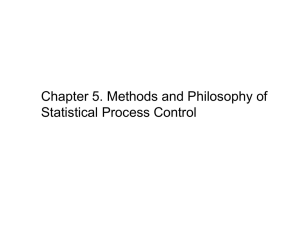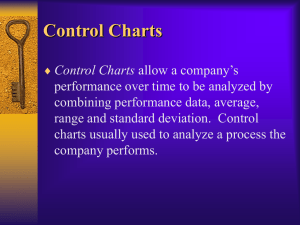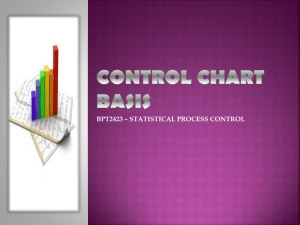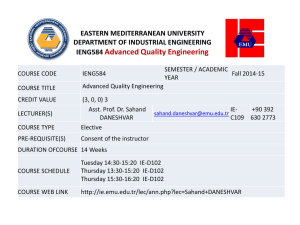experiment 4 - Department of Mechanical Engineering, METU
advertisement
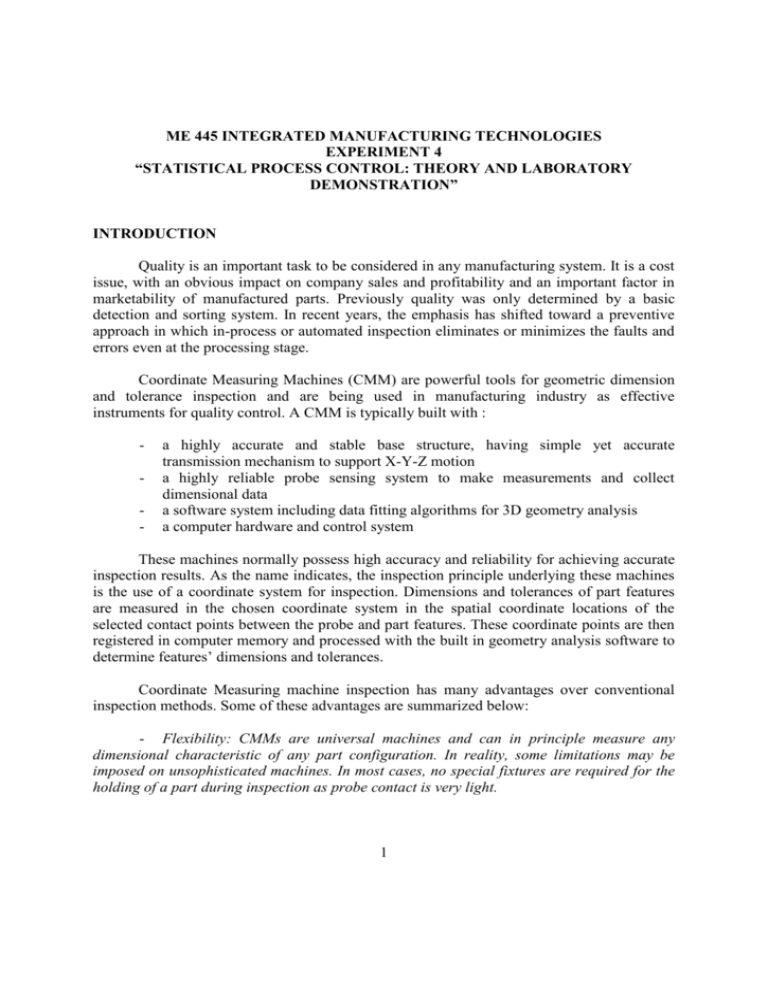
ME 445 INTEGRATED MANUFACTURING TECHNOLOGIES EXPERIMENT 4 “STATISTICAL PROCESS CONTROL: THEORY AND LABORATORY DEMONSTRATION” INTRODUCTION Quality is an important task to be considered in any manufacturing system. It is a cost issue, with an obvious impact on company sales and profitability and an important factor in marketability of manufactured parts. Previously quality was only determined by a basic detection and sorting system. In recent years, the emphasis has shifted toward a preventive approach in which in-process or automated inspection eliminates or minimizes the faults and errors even at the processing stage. Coordinate Measuring Machines (CMM) are powerful tools for geometric dimension and tolerance inspection and are being used in manufacturing industry as effective instruments for quality control. A CMM is typically built with : - a highly accurate and stable base structure, having simple yet accurate transmission mechanism to support X-Y-Z motion a highly reliable probe sensing system to make measurements and collect dimensional data a software system including data fitting algorithms for 3D geometry analysis a computer hardware and control system These machines normally possess high accuracy and reliability for achieving accurate inspection results. As the name indicates, the inspection principle underlying these machines is the use of a coordinate system for inspection. Dimensions and tolerances of part features are measured in the chosen coordinate system in the spatial coordinate locations of the selected contact points between the probe and part features. These coordinate points are then registered in computer memory and processed with the built in geometry analysis software to determine features’ dimensions and tolerances. Coordinate Measuring machine inspection has many advantages over conventional inspection methods. Some of these advantages are summarized below: - Flexibility: CMMs are universal machines and can in principle measure any dimensional characteristic of any part configuration. In reality, some limitations may be imposed on unsophisticated machines. In most cases, no special fixtures are required for the holding of a part during inspection as probe contact is very light. 1 - Reduction of setup time: In conventional geometry inspection, part alignment and establishment of appropriate reference points are difficult tasks and consequently, these inspection processes are labor intensive and time consuming. With CMMs, an inspector can set up a part in a convenient orientation for the inspection and, because it uses a coordinate system and a set of data fitting algorithms, all coordinate data measured is subsequently corrected according to the calibration of the part and the probe. Thus, the time for setup is minimized for part inspection and inspection efficiency is improved. - Improved Accuracy: All measurements are carried out using a common measuring system, so the accumulation of errors that would have resulted from hand-gauge inspection methods is avoided. Also, the operator’s influence is kept at a minimum level, and hence the inspection quality is consistent. - Automation: CMMs are fully equipped with a computer system and use high-level control languages for their programming and, therefore, they have potential for automated inspection and integration with CAD systems. STATISTICAL PROCESS CONTROL Although accuracy is of great importance to engineers, absolute accuracy is unattainable. Even gage blocks of the highest order of accuracy have manufacturing tolerances which are as small as a few hundred thousands of a millimeter. These tolerances, whose magnitude depends on the function of a component, are necessary to allow for the inherent variability of the production processes. When the quantity involved is large, the pattern of variation can be studied on a statistical basis. Then it becomes possible to assess the quality achieved by the process without testing every piece produced. Various applications for statistics in quality control were achieved following the introduction of statistical control method, but among all of the SPC techniques, control charts proved the most efficient. Control charts are used to determine the inherent variation in a process. As long as the data related to the process are within constructed control limits and presents a normal distribution, the process is considered stable and the resulting variation in the process acceptable. However if any data lies outside the limit or show abnormal variations, assignable sources of error in the process can be suggested thus ensuring a path of quality production. The benefits of control charts are simply as follows: - Products have minimum variation among themselves. With stable processes, inspection can be reduced or eliminated altogether. The width of control limits is a measure of the process capability. This information is used to enhance product quality through design by matching the process capability with design tolerances. 2 SPC is the whole technical and managerial effort to control the manufacturing processes for improving and maintaining quality and the technique proves fulfill these tasks simultaneously. SPC cannot be limited to the control charts only. It is also a diagnostic tool such that it provides the hints on where the problem exists and what the probable causes are. Implementing SPC begins with the task of knowing the process in terms of what is called process capability. Process capability refers to the extent of variation in the product data when the process is stable. It is established by tracking the process spread for specific combinations of tooling, workpiece material and even the operator. The benefits of SPC briefly are: - The process planner knows what the shop can do. The operator knows immediately when the process begins to behave abnormally. Rejected products decrease. Obviously the burden of analyzing the process data is quite much. To relieve this burden various analyzers and software packages are developed. These commercial packages and tools helps operator in quickly interpreting measurement data thus provide an ease in quickly detecting abnormal process variations. CONTROL CHARTS FOR VARIABLES DATA The key task in improving quality is to reduce the variability of the quality characteristic of product, e.g. the diameter of cylinder bore. Obviously the variation of a characteristic depends on some reason which is further classified as common causes and special causes. A process is said to be in statistical control if only common causes are present. However special or assignable causes may shift the process state to out-of-control and lead to production of non-conforming products. In order to detect and eliminate such causes in a process, control charts are utilized. Quality characteristic Control charts are graphical presentation of quality characteristic measured on a sample versus the sample number or time. Three essential elements of a control chart are the center line, an upper control limit and a lower control limit line. The figure below illustrates a sample control chart. The control charts are classified into two general categories: variable control chart and attribute control chart. UC L CL LCL 3 Order of sampling Variables data, that is used to construct the variables control charts, is data that is acquired through measurements, such as length, time, diameter, strength, height, temperature, density, thickness, pressure, and height. Variables data is normally analyzed in pairs of charts which present data in terms of location or central tendency and spread. Location, usually the top chart, shows data in relation to the process average. It is presented in X , individuals, or median charts. Spread, usually the bottom chart, looks at piece-by-piece variation. Range, , and moving range charts are used to illustrate process spread. Another aspect of these variables control charts is that the subgroup size is generally constant. The two most frequently used control charts are the X and R charts. These charts are used to monitor and control the process mean and range of variability. The sample size for these charts is larger than two, i.e. at least two specimen are measured to create a subgroup. Analyzing variables charts for special cause variation depends on the assessing of the patterns arise in the constructed chart. Some of the typical patterns indicating lack of control can be presented as follows: - any point lying outside the control limits seven or more points in a row above or below the centerline seven or more points in a row going in one direction, up or down systematic, non-random fluctuations, such as cycles, sawtooth patterns When these patterns develop and the process state is declared to be out-of-control, the diagnosis stage will start. Patterns on X charts are affected by causes which are capable of affecting all units produced at once or in the same general way. Examples of some of these changes that may affect the X chart are: - material defects - inspector error - supplier changes - operator error - machine setting - unusual tool wear The range chart measures the uniformity or consistency of the process. Assignable causes for changes in R charts are due to some units receiving different treatment from others, thus reflecting variability. Ideally, values and level of the R chart should be as low as possible. Causes which affect only part of the units being produced will cause variations and out-of-control readings on the range chart. Some of the assignable causes of R-chart variability may be: - poorly trained operator or inspector non-uniform materials machine out of adjustment or repair non-standard parts at beginning or end of run 4 X – R CHARTS An X and R (range) chart is a pair of control charts used with processes that have a subgroup size of two or more. X and R charts are used to determine if a process is stable and predictable. The X chart shows how the mean or average changes over time and the R chart shows how the range of the subgroups changes over time. It is also used to monitor the effects of process improvement studies. X and R charts can be used for any process with a subgroup size greater than one. Typically, it is used when the subgroup size falls between two and nine. X and R charts are used when the answer to the following questions is yes: - Do you need to assess system stability? - Is the data in variables form? - Is the data collected in subgroups larger than one but less than eleven? - Is the time order of subgroups preserved? Before calculating control limits as many subgroups as possible should be collected. With smaller amounts of data, the X and R chart may not represent variability of the entire system. The more subgroups used in control limit calculations, the more reliable the analysis. Typically, twenty to twenty-five subgroups will be used in control limit calculations. X and R charts have several applications. When a system is to be improved, these charts are used to assess the system’s stability. After the stability has been assessed, the need to stratifying the data should be determined. Entirely different results may occur between shifts, among workers, among different machines, among lots of materials, etc. To see if variability on the X and R chart is caused by these factors, data should be collected and entered in a way that lets stratifying by time, location, operator, and lots. X and R charts can also be used to analyze the results of process improvements. It would be considered how the process is running and compared to how it ran in the past and if process changes produce the desired improvement. The most common (and recommended) method of computing control limits for X chart with range and range chart based on three standard deviations is: Upper Control Limits: UCLX X A2 R UCLR D4 R 5 Lower Control Limits: LCLX X A2 R LCLR D3 R where X is the average of the mean of values in group of observations and R is the average of the range values. A2, D3 and D4 are read from table of control limits. D3 does not exist for subgroup sizes less than seven, so the lower control limit for range charts with subgroup size less than seven is zero. Factors for X and R Charts Control Limits Subgroup Size A2 d2 2 3 4 5 6 7 8 9 10 11 12 13 14 15 16 17 18 19 20 21 22 23 24 25 1.880 1.023 0.729 0.577 0.483 0.419 0.373 0.337 0.308 0.285 0.266 0.249 0.235 0.223 0.212 0.203 0.194 0.187 0.180 0.173 0.167 0.162 0.157 0.153 1.128 1.693 2.059 2.326 2.534 2.704 2.847 2.970 3.078 3.173 3.258 3.336 3.407 3.472 3.532 3.588 3.640 3.689 3.735 3.778 3.819 3.858 3.859 3.931 6 D3 D4 -------------------------0.076 0.136 0.184 0.223 0.256 0.283 0.307 0.328 0.347 0.363 0.378 0.391 0.403 0.415 0.425 0.434 0.443 0.451 0.459 3.276 2.574 2.282 2.114 2.004 1.924 1.864 1.816 1.777 1.276 1.717 1.693 1.672 1.653 1.637 1.622 1.608 1.597 1.585 1.276 1.566 1.557 1.548 1.541 PROCESS CAPABILITY Control chart is an effective way in controlling assignable process variations, but it is powerless for normal variations. Normal process variations are measured by the process capability index Cp and Cpk. Process capability study relates the needs of the design with the capabilities of the process. Cp implies the process capability index which is defined as: Cp USL LSL 6 where denotes the process standard deviation and USL-LSL is the difference between the upper and lower specification limits set during design stage, i.e. tolerance. The process capability index Cp by itself is unable to measure process performance in terms of target or nominal value fixed by the designer. This performance is measured by the other parameter Cpk and defined as C pk Z 3 where Z is the smaller of USL- X or X -LSL and X is is the average of the mean of values in group of observations Analysis of process capability is a vital part of a quality improvement system. The followings are among the major uses of a process capability study: - Predicting how well the process will hold the tolerances. - Assisting in design stage in selecting or modifying a process. - Assisting in establishing an interval between sampling for process control. - Specifying performance requirements for new equipment. - Planning the sequence of production processes when there is an interactive effect of processes on tolerances. - Reducing the variability in a manufacturing process. The figure below presents an example analysis method for process capability interpretation. 7 8 LABORATORY WORK The primary aim of this demonstration is to present quality control capabilities of the METUCIM system. The Coordinate Measuring Machine (CMM) that exists in the system is utilized for the dimensional inspection and analysis of manufactured parts. The machine has certain measurement capabilities which are to be presented during the demonstration. The automatic measurement programming feature of the CMM allows efficient use of such machines in automated manufacturing systems. During the laboratory demonstration, a sample measurement operation will be carried out. Measurement of different features and automatic measurement exercises will be done. The collected data for a number of measured workpieces will be recorded. As an output for the study a process control chart for a given subgroup size will be prepared and necessary comments on the control chart and process capability figures will be presented. Below figure shows the dimensions and tolerances on the sample workpiece that is going to be measured. 8.00.1 12 0.1 20 0.1 6.0 0.1 0.2 C C 9 14.5 0.1 PROCESS CONTROL CHART Lot No: 1 Operation : Turning M/C Tool : CNC Lathe Control Point: A Work Limits : 50.00 +0.24 mm 50.00 mm Production rate : 200 parts/hr Sampling rate : 10% (20 parts/hr) Sample size : 5 Sampling period : 15 min x : 50.130 UCL = x +A2 * R = 50.177 LCL = x -A2 * R = 50.083 Measured R = d2 R : 0.081 UCL = D4 * R = 0.171 LCL = D3 * R = 0.0 Measured 0.035 Cp = 1.143 Cpk = 1.048 SAMPLE PROCESS CONTROL CHART x1 x2 x3 x4 x5 x6 x R Sample No Time Date 50.080 50.100 50.110 50.100 50.080 50.120 50.110 50.090 50.120 50.080 50.150 50.090 50.110 50.150 50.090 50.160 50.150 50.090 50.150 50.100 50.100 50.160 50.080 50.130 50.140 50.150 50.090 50.170 50.090 50.170 50.160 50.170 50.110 50.170 50.100 50.090 50.150 50.160 50.210 50.140 50.100 50.100 50.230 50.160 50.170 50.110 50.240 50.110 50.140 50.170 50.094 0.030 1 8:15 50.104 0.040 2 8:30 50.118 0.060 3 8:45 50.130 0.070 4 9:00 50.122 0.080 5 9:15 50.134 0.080 6 9:30 50.142 0.070 7 9:45 50.150 0.120 8 10:00 50.152 0.130 9 10:15 50.154 0.130 10 10:30 Average Chart 50.250 USL 50.200 UCL 50.150 mean 50.100 LCL 50.050 50.000 LSL 49.950 1 2 3 4 5 6 7 8 9 10 Sample No Range Chart 0.200 UCL 0.150 0.100 0.050 10 0.000 1 2 3 4 5 6 Sample No 7 8 9 10 11


